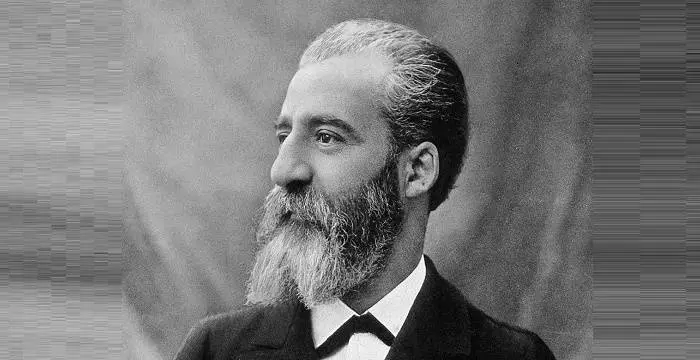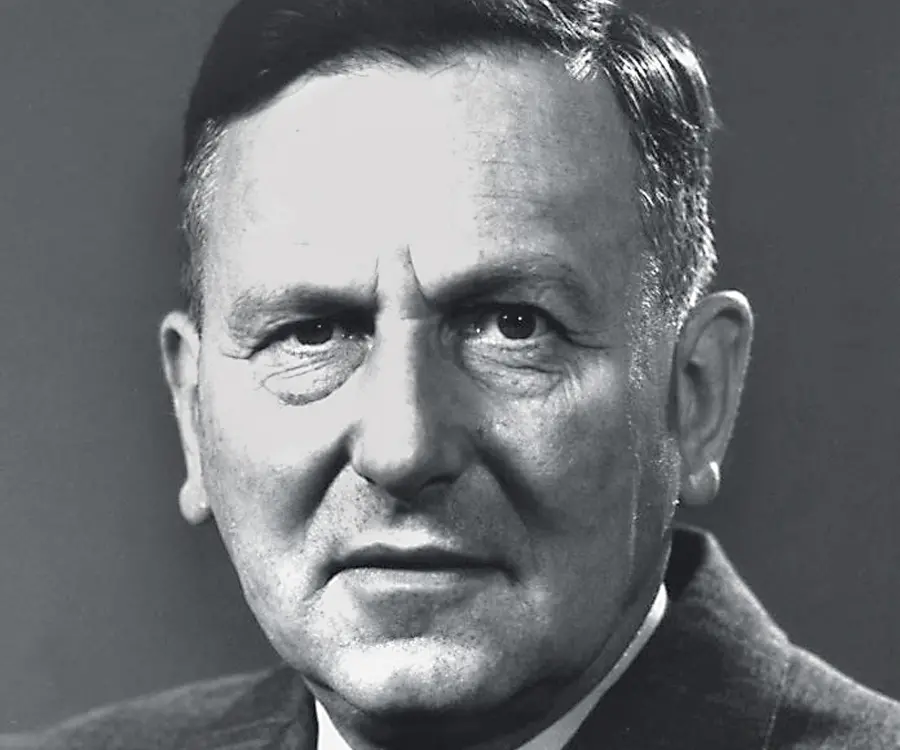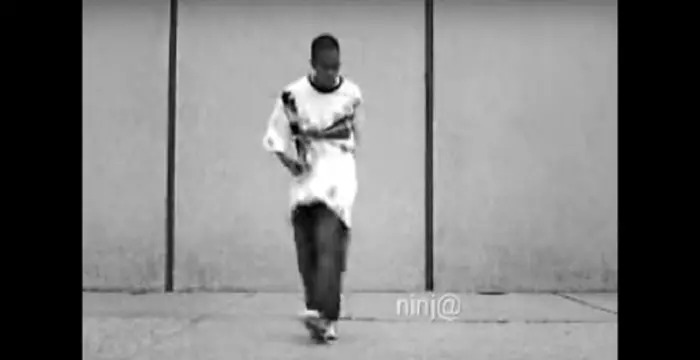
Paul Hermann Müller - Inorganic Chemists, Life Achievements and Family
Paul Hermann Müller's Personal Details
Paul Hermann Muller was a Swiss Chemist who won the Nobel Prize in Physiology or Medicine for his discovery of a form of DDT
| Information | Detail |
|---|---|
| Birthday | January 12, 1899 |
| Died on | October 12, 1965 |
| Nationality | Swiss |
| Famous | Scientists, Chemists, Inorganic Chemists |
| Known as | Paul Hermann Muller |
| Universities |
|
| Birth Place | Olten, Solothurn, Switzerland |
| Gender | Male |
| Sun Sign | Capricorn |
| Born in | Olten, Solothurn, Switzerland |
| Famous as | Chemist |
| Died at Age | 66 |
// Famous Inorganic Chemists
William Ramsay
William Ramsay was a Nobel Prize winning chemist who discovered the ‘noble gases’. To know more about his childhood, profile, timeline and career read on
Alfred Werner
Alfred Werner was a Swiss chemist and the founder of coordination chemistry. This biography of Werner provides detailed information about his childhood, life, research, work, achievements and timeline.
Henri Moissan
Ferdinand Frederick Henri Moissan was a French Chemist who won the Nobel Prize in Chemistry in 1936. Check out this biography to know about his childhood, life, achievements, works & timeline.
Paul Hermann Müller's photo
Who is Paul Hermann Müller?
Paul Hermann Muller was a Swiss Chemist who won the Nobel Prize in Physiology or Medicine for his discovery of a form of DDT which could kill insects when they came into contact with it. Though DDT had been available since 1873 it had to be ingested by the insects to be effective like all other insecticides till that time. This was an important discovery as DDT was used to kill mosquitoes carrying the malaria virus and helped save a large number of Allied soldiers fighting in the Far East. The shirts of the American and British troops were impregnated with DDT. The first large scale use of DDT was made in Naples, Italy, in 1943 to check a typhus epidemic which could be brought under control within three weeks of using the chemical. The biggest success of this chemical was its ability to reduce the incidence of malaria in different parts of the world by killing the mosquitoes that carried the germ. He developed substances for the tanning of leather that were synthetic in nature but produced fast colors. He also found out methods to conserve hides and to make wool and textile resistant to moths. His interest in botany also helped him discover a seed dressing which was free from mercury and helped the Swiss farmers.
// Famous Scientists
Juliane Koepcke
Juliane Koepcke is a German-Peruvian biologist, who was the lone survivor among the 92 passengers and crew of the ill-fated LANSA Flight 508 that crashed in the Peruvian rainforest on 24 December 1971. Know more about her life in this biography.
Henry Cavendish
Henry Cavendish was a theoretical chemist and physicist, renowned for discovery of hydrogen and calculation of the mass of earth. To know more about his childhood, profile, timeline and career read on
Konstantin Tsiolkovsky
Konstantin Tsiolkovsky was a Russian rocket scientist and a pioneer of astronautics. This biography provides detailed information about his childhood, family, personal life, career, achievements, etc.
Childhood & Early Life
Paul Herman Muller was born in Olten, Solothurn, Switzerland on January 12, 1899. His father, Gottlieb Muller, was an official of the Swiss Federal Railways and his mother was Fanny Leopold.
He was the oldest of the four children in the Muller family.
He spent most of his early childhood in Lenzburg, in Aargau, but had to move to Basel at the age of five when his father was transferred there. After moving to Basel, Muller attended a primary school.
He attended the ‘Freie Evangelische Volsschule’ elementary and secondary schools later.
In 1916 he worked as a laboratory technician for a brief period in the chemical factory of Dreyfus & Company.
In 1917 he joined Lonza A. G. laboratories as a research chemist in the scientific-industrial laboratory and worked there for a year.
He returned to his old school, passed his matriculation examination in 1918 and obtained his diploma in 1919.
Convinced that chemistry was his future, he joined the Basel University in 1919.
In 1922 he changed his work to organic chemistry from inorganic chemistry.
He received his PhD from the University in April, 1925, for a thesis on the oxidation of ‘m-xylidine’ and its derivatives. He also studied physical chemistry and botany at the university.
Career
On May 25, 1925 Muller joined as a research chemist in the dye division of the firm ‘J. R. Geigy’ which produced synthetic dyes, plant-based dyes and tanning agents that were available in nature. He remained with this company for the rest of his life.
In 1930 he developed synthetic tanning agents and dyes which remained fast under sunlight.
In 1935 he started a study on insecticides that could affect insects coming into contact with them. He stressed upon the various criteria of a perfect insecticide that would make it cheap, highly stable for long periods, prove highly potent against all types of insects without causing any harm to plants, animals or humans.
In 1937 he developed and patented a method for producing insecticides out of synthetic cyanate and rhodanide based compounds.
He also developed a mercury-free seed disinfectant called Graminone which benefited the Swiss farmers a great deal at the time.
In 1939 Muller developed DDT or ‘dichloro diphenyl trichloroethane’ which did not have much use since it was first discovered in 1873. Till that time all insecticides were either natural which were very expensive or synthetic which were ineffective. The effective insecticides available till then were Arsenic based and were equally poisonous to humans, animals and plants.
Muller got a Swiss patent for it in 1940 and production of DDT was started by Geigy. He also got a British patent in 1942 and an American patent in 1943 after which the production of insecticide started in both the countries in real earnest.
It was first tested on the Colorado potato beetle in 1943 by both the US and the Swiss governments with great success.
It was successfully used to stop a typhus epidemic in Naples, Italy in 1943. Over the years the insecticide started showing signs of other toxicities harmful to animals and humans and its used was drastically reduced.
Muller later became the deputy chairman of J. R. Geigy and the director of research in its pesticide division.
In 1961 he retired from Geigy and carried out more experiments at the laboratory set up at his Oberswil home.
Major Works
Paul Hermann Muller’s investigations in ‘Uber Konstitiution und Toxische Wirkung von naturlichen und neuen synthetischen insektentotenden Stoffen’ written with H. Martin and P. Lauger came out in ‘Helevetica chimica acta’ in 1944.
His paper with the title ‘Uber Zusmmenhange zwischen Konstitution und insektizider Wirkung’ was published in 1946.
He gave an account of the discovery of DDT in ‘Dichlorodiphenyltrichloroathan und neuere Inzekticide’ which was published in 1949.
Awards & Achievements
Paul Hermann Muller was awarded the Nobel Prize in Physiology or Medicine in 1948.
He was awarded an honorary doctorate by the University of Thessalonica in recognition of his discovery of the new form of DDT which was used effectively in the Mediterranean countries.
Personal Life & Legacy
He married Friedel Ruegsegger in 1927 and had two son, Heinrich and Niklaus and one daughter, Margaretha from the marriage.
Paul Hermann Muller died on October 12, 1965 in Basel, Switzerland.
Humanitarian Work
Paul Hermann Muller was instrumental in saving millions of lives by eradicating malaria from many countries and reducing its incidence in a big part of the world by discovering DDT.
// Famous Chemists
Henry Cavendish
Henry Cavendish was a theoretical chemist and physicist, renowned for discovery of hydrogen and calculation of the mass of earth. To know more about his childhood, profile, timeline and career read on
Walter Kohn
Nobel Laureate Walter Kohn was an Austrian-born American theoretical chemist and physicist. Check out this biography to know about his childhood, life, achievements, works & timeline.
Jabir Ibn Hayyan
Jabir Ibn Hayyan was a medieval era polymath. Check out this biography to know about his life, works and achievements.
Paul Hermann Müller biography timelines
- // 1873 To 1939In 1939 Muller developed DDT or ‘dichloro diphenyl trichloroethane’ which did not have much use since it was first discovered in 1873. Till that time all insecticides were either natural which were very expensive or synthetic which were ineffective. The effective insecticides available till then were Arsenic based and were equally poisonous to humans, animals and plants.
- // 12th Jan 1899Paul Herman Muller was born in Olten, Solothurn, Switzerland on January 12, 1899. His father, Gottlieb Muller, was an official of the Swiss Federal Railways and his mother was Fanny Leopold.
- // 1916In 1916 he worked as a laboratory technician for a brief period in the chemical factory of Dreyfus & Company.
- // 1917In 1917 he joined Lonza A. G. laboratories as a research chemist in the scientific-industrial laboratory and worked there for a year.
- // 1918 To 1919He returned to his old school, passed his matriculation examination in 1918 and obtained his diploma in 1919.
- // 1919Convinced that chemistry was his future, he joined the Basel University in 1919.
- // 1922In 1922 he changed his work to organic chemistry from inorganic chemistry.
- // 1925He received his PhD from the University in April, 1925, for a thesis on the oxidation of ‘m-xylidine’ and its derivatives. He also studied physical chemistry and botany at the university.
- // 25th May 1925On May 25, 1925 Muller joined as a research chemist in the dye division of the firm ‘J. R. Geigy’ which produced synthetic dyes, plant-based dyes and tanning agents that were available in nature. He remained with this company for the rest of his life.
- // 1927He married Friedel Ruegsegger in 1927 and had two son, Heinrich and Niklaus and one daughter, Margaretha from the marriage.
- // 1930In 1930 he developed synthetic tanning agents and dyes which remained fast under sunlight.
- // 1935In 1935 he started a study on insecticides that could affect insects coming into contact with them. He stressed upon the various criteria of a perfect insecticide that would make it cheap, highly stable for long periods, prove highly potent against all types of insects without causing any harm to plants, animals or humans.
- // 1937In 1937 he developed and patented a method for producing insecticides out of synthetic cyanate and rhodanide based compounds.
- // 1943It was first tested on the Colorado potato beetle in 1943 by both the US and the Swiss governments with great success.
- // 1943It was successfully used to stop a typhus epidemic in Naples, Italy in 1943. Over the years the insecticide started showing signs of other toxicities harmful to animals and humans and its used was drastically reduced.
- // 1944Paul Hermann Muller’s investigations in ‘Uber Konstitiution und Toxische Wirkung von naturlichen und neuen synthetischen insektentotenden Stoffen’ written with H. Martin and P. Lauger came out in ‘Helevetica chimica acta’ in 1944.
- // 1946His paper with the title ‘Uber Zusmmenhange zwischen Konstitution und insektizider Wirkung’ was published in 1946.
- // 1948Paul Hermann Muller was awarded the Nobel Prize in Physiology or Medicine in 1948.
- // 1949He gave an account of the discovery of DDT in ‘Dichlorodiphenyltrichloroathan und neuere Inzekticide’ which was published in 1949.
- // 1961In 1961 he retired from Geigy and carried out more experiments at the laboratory set up at his Oberswil home.
- // 12th Oct 1965Paul Hermann Muller died on October 12, 1965 in Basel, Switzerland.
// Famous Capricorn Celebrities peoples
Weston Koury
All about American social media star Weston Koury, including his age, family life, girlfriends, birthday, and some fun facts.
Elin Nordegren
Elin Nordegren is the ex-wife of Tiger Woods. Check out this biography to know about her childhood, family life, achievements and fun facts about her life.
ItsJustNick
ItsJustNick is a Canadian YouTube star & social media personality. Let’s take a look at his family and personal life including age, date of birth, net worth, girlfriends, and fun facts.
Rudan Custodio
Check out all that you wanted to know about Rudan Custodio, the famous American YouTube Personality; his birthday, his family and personal life, his girlfriends, fun trivia facts and more.
Zahara Jolie-Pitt
Zahara Jolie-Pitt is the adopted daughter of former celebrity couple Angelina Jolie and Brad Pitt. Check out this biography to know about her childhood, family life and fun facts about her.
Adam Dahlberg
Check out all that you wanted to know about Adam Dahlberg, the famous YouTuber and gamer; his birthday, his family and personal life, his wife, fun trivia facts and more.
Paul Hermann Müller's FAQ
What is Paul Hermann Müller birthday?
Paul Hermann Müller was born at 1899-01-12
When was Paul Hermann Müller died?
Paul Hermann Müller was died at 1965-10-12
Where was Paul Hermann Müller died?
Paul Hermann Müller was died in Basel
Which age was Paul Hermann Müller died?
Paul Hermann Müller was died at age 66
Where is Paul Hermann Müller's birth place?
Paul Hermann Müller was born in Olten, Solothurn, Switzerland
What is Paul Hermann Müller nationalities?
Paul Hermann Müller's nationalities is Swiss
What was Paul Hermann Müller universities?
Paul Hermann Müller studied at University of Basel
What is Paul Hermann Müller's sun sign?
Paul Hermann Müller is Capricorn
How famous is Paul Hermann Müller?
Paul Hermann Müller is famouse as Chemist















